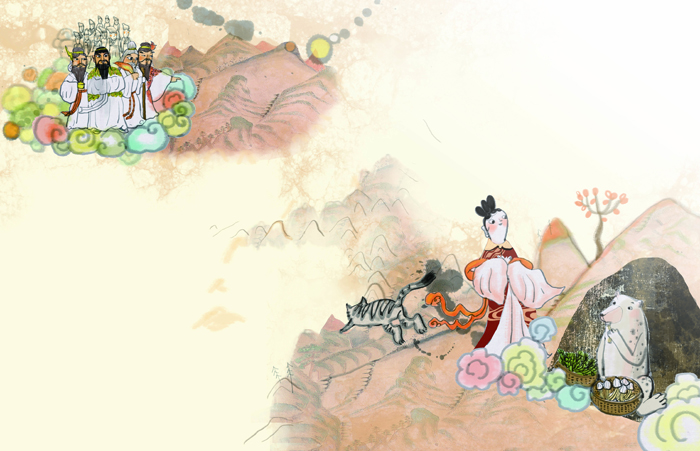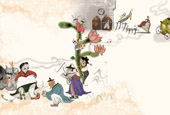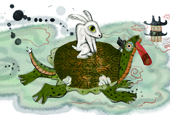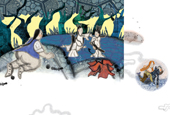View this article in another language
- 한국어
- English
- 日本語
- 中文
- العربية
- Español
- Français
- Deutsch
- Pусский
- Tiếng Việt
- Indonesian
Although the modern Republic of Korea is young, ancient Korean history stretches back more than 4,000 years to include centuries of warring kingdoms, oscillating political borders, and countless dynasties. In the beginning there was Joseon, the first Korean kingdom, and the first Korean king, founding father Emperor Dangun. Today we call this ancient Joseon “Gojoseon,” or literally “old Joseon,” to differentiate it from the Joseon Dynasty that came a few thousand years later. This kingdom covered an area that today includes parts of Manchuria as well as the entire Korean Peninsula. Beyond these facts, history merges with legend, with variations of the Dangun legend scattered throughout Chinese and Korean history books of the era. Most versions place the year of his founding at 2333 BCE.
Divine Lineage
But as with many Korean founding legends, the real story begins before Dangun’s birth, with his ancestry. The Dangun story begins with Hwanung, son of Hwanin, a god who lived in the heavens. Hwanung, however, wanted to live on Earth. He descended onto the peak of Taebaeksan Mountain, beneath Sindansu, a sacred tree, accompanied by 3,000 followers. He established Sinsi, his sacred city. Hwanung ruled over the people of the land, motivated by the noble aim of benefiting humankind.

Then two animals, a bear and a tiger, came to Hwanung and begged him to let them become human. Hwanung gave them garlic and ssuk, a type of fragrant mugwort that remains a highly popular ingredient in many Korean foods today. He instructed them to avoid sunlight for 100 days and survive on his prescribed diet of garlic and ssuk, saying that they could earn their humanity if they succeeded in this.
The tiger gave up midway. But the bear persevered and became a woman. Her name was Ungnyeo—literally “Bear Woman.” But womanhood wasn’t enough for the former bear. She prayed beneath the sacred tree for a baby, and Hwanung, who heard her prayers, briefly transformed himself into a human to wed her. She bore him a son. This son was Dangun.
Sometimes he is called Emperor Dangun or Dangun Wanggeom. Dangun established his capital in the city of Pyongyang (later moving it to Asadal, or originally establishing it in Asadal by some accounts) and called his kingdom Joseon. He ruled for 1,500 years before he became a mountain god at the ripe old age of 1,908.
Dangun’s curious pedigree is only one of the many fantastic aspects of his legend, but if it lacks believability when taken literally, various interpretations suggest intriguing historical insights. For example, some theories infer that the marriage of Hwanung, representing the sky, and Ungnyeo, representing the Earth, represented a political marriage between two tribes of different religions. Other theories suggest that Dangun’s mixed ancestry (bear and deity) was an attempt to justify a ruler who was both priest and king, who ruled over political as well as religious affairs. The “Dangun” in “Dangun Wanggeom” refers to his religious authority, while the “Wanggeom” title indicates that he was also a political leader.
And despite inconsistencies between historical accounts, ultimately Dangun is still considered the founder of this nation. Today he is celebrated with Gaecheonjeol, or National Founder’s Day, on October 3 of the lunar calendar. The birth and existence of the legend itself is also significant in that it speaks to a budding sense of national identity. The following Goguryeo Kingdom adopted the Dangun legend as a way of emphasizing its independence as a kingdom with a coherent identity. Since then Dangun and his story have often served as a romantic mascot for patriotic needs.
Written by Violet Kim
Illustrated by Shim Soo-keun
*The series of old Korean tales has been made possible with the cooperation with Korea Magazine.
Divine Lineage
But as with many Korean founding legends, the real story begins before Dangun’s birth, with his ancestry. The Dangun story begins with Hwanung, son of Hwanin, a god who lived in the heavens. Hwanung, however, wanted to live on Earth. He descended onto the peak of Taebaeksan Mountain, beneath Sindansu, a sacred tree, accompanied by 3,000 followers. He established Sinsi, his sacred city. Hwanung ruled over the people of the land, motivated by the noble aim of benefiting humankind.

Then two animals, a bear and a tiger, came to Hwanung and begged him to let them become human. Hwanung gave them garlic and ssuk, a type of fragrant mugwort that remains a highly popular ingredient in many Korean foods today. He instructed them to avoid sunlight for 100 days and survive on his prescribed diet of garlic and ssuk, saying that they could earn their humanity if they succeeded in this.
The tiger gave up midway. But the bear persevered and became a woman. Her name was Ungnyeo—literally “Bear Woman.” But womanhood wasn’t enough for the former bear. She prayed beneath the sacred tree for a baby, and Hwanung, who heard her prayers, briefly transformed himself into a human to wed her. She bore him a son. This son was Dangun.
Sometimes he is called Emperor Dangun or Dangun Wanggeom. Dangun established his capital in the city of Pyongyang (later moving it to Asadal, or originally establishing it in Asadal by some accounts) and called his kingdom Joseon. He ruled for 1,500 years before he became a mountain god at the ripe old age of 1,908.
Dangun’s curious pedigree is only one of the many fantastic aspects of his legend, but if it lacks believability when taken literally, various interpretations suggest intriguing historical insights. For example, some theories infer that the marriage of Hwanung, representing the sky, and Ungnyeo, representing the Earth, represented a political marriage between two tribes of different religions. Other theories suggest that Dangun’s mixed ancestry (bear and deity) was an attempt to justify a ruler who was both priest and king, who ruled over political as well as religious affairs. The “Dangun” in “Dangun Wanggeom” refers to his religious authority, while the “Wanggeom” title indicates that he was also a political leader.
And despite inconsistencies between historical accounts, ultimately Dangun is still considered the founder of this nation. Today he is celebrated with Gaecheonjeol, or National Founder’s Day, on October 3 of the lunar calendar. The birth and existence of the legend itself is also significant in that it speaks to a budding sense of national identity. The following Goguryeo Kingdom adopted the Dangun legend as a way of emphasizing its independence as a kingdom with a coherent identity. Since then Dangun and his story have often served as a romantic mascot for patriotic needs.
Written by Violet Kim
Illustrated by Shim Soo-keun
*The series of old Korean tales has been made possible with the cooperation with Korea Magazine.




